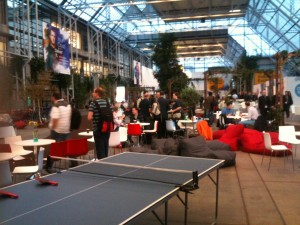One of the most interesting sessions I attended at VMworld in Copenhagen was entitled ‘Cloud Computing 2012 to 2014 – a two year perspective’ (session CIM4603, subscription required). The speaker was Joe Baguley, a well known cloud evangelist who recently joined VMware as Chief Cloud Technologist. I’ve seen Joe present before at the Cloud Camp events so knew what to expect (humour, lots of snappy analogies and some thought provoking concepts) and I wasn’t disappointed (note the link above is to the same session from Las Vegas, presented with his own slant by David Hunter). If you’re interesed in hearing Joe’s speech in person I recommend registering for the national VMUG taking place on 3rd November in Birmingham.
 One of Joe’s analogies (well quoted in the press) was to compare VM encapsulation to a shipping container. This isn’t anything new (Chuck Hollis explains it very well in this blogpost from 2008!) but it’s an analogy I’ve been thinking about since buying the book ‘The Box‘ for my wife as a Christmas present last year. As a commodity trader working with a team of shippers I thought she’d find a book about the history of the shipping container interesting (the New York Times listed it as one of the best business books ever written) but instead I found myself reading it during a weekend break. It didn’t take long to see parallels with what’s been happening over the last few years in the IT industry;
One of Joe’s analogies (well quoted in the press) was to compare VM encapsulation to a shipping container. This isn’t anything new (Chuck Hollis explains it very well in this blogpost from 2008!) but it’s an analogy I’ve been thinking about since buying the book ‘The Box‘ for my wife as a Christmas present last year. As a commodity trader working with a team of shippers I thought she’d find a book about the history of the shipping container interesting (the New York Times listed it as one of the best business books ever written) but instead I found myself reading it during a weekend break. It didn’t take long to see parallels with what’s been happening over the last few years in the IT industry;
- Standardisation and automation altered existing business models – some companies flourished and others perished
- Whole professions changed and those who didn’t adapt found themselves out of work
- Containerisation introduces new challenges (scale, security)
- The container was used for many purposes beyond it’s original remit
In the four years since Chuck wrote his post the practice of cloud computing has advanced considerably. Whereas his focus (in that post at least) was networking it’s now clear that most areas of IT are being impacted from infrastructure to applications.
This isn’t a ‘technical how to’ blogpost with any conclusions but more of a ‘wandering thoughts, slow day at work’ post. I’m going to explore the analogy a bit further and include a few miscellaneous facts which were too good to ignore!
Continue reading Container shipping and virtualisation – a potent analogy



